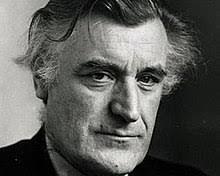We have decided to create the most comprehensive English Summary that will help students with learning and understanding.
The Laburnum Top Poem Summary in English by Ted Hughes
The Laburnum Top Poem by Ted Hughes About the Poet
| Name | Ted Hughes |
| Born | 17 August 1930, Mytholmroyd, United Kingdom |
| Died | 28 October 1998, North Tawton, United Kingdom |
| Education | Pembroke College, University of Cambridge |
| Spouse | Carol Orchard (m. 1970–1998), Sylvia Plath (m. 1956–1963) |
| Awards | Costa Book of the Year, Guggenheim Fellowship for Creative Arts, US & Canada, Guardian Children’s Fiction Prize |

The Laburnum Top Poem Summary in English
Laburnum is known as amaltas in Hindi.
On a bright September afternoon, the laburnum, a short tree with hanging branches and yellow flowers, stood soundless and motionless. A few leaves that had yellowed and some seeds lay scattered around it. Just then, all of a sudden a small singing bird with yellow feathers on its wings, the goldfinch, arrived chirping. She entered the foliage like a lizard—smooth, watchful and hasty.
As she entered, the tree suddenly seemed to come alive. It started up like a machine. There were shrill sounds of twittering arid the tree seemed to quiver with joy. The mother bird was like the engine of her family. Like an engine she added life to the tree and flitted from branch to branch, showing her striped face, with yellow and black markings that were peculiar to her. Then with a mysterious, low whistle she flew off into the sky. Once again the laburnum quietened down as it was before her arrival.
The Laburnum Top Poem Summary Questions and Answers
1. The Laburnum top is silent, quite still
In the afternoon yellow September sunlight,
A few leaves yellowing, all its seeds fallen.
a. Mention the poetic device used in the ‘The Laburnum top is silent, quite still’. Why has it been used? Alteration. The Laburnum top is silent, quite still. The repeated sound creates a musical effect.
b. Mention the colour suggested by the poet. Also mention the words that suggest colour.
The colour is yellow. The colour is suggested by the yellow September sunlight and the yellowing leaves.
c. What is the stillness disturbed by?
It is disturbed by the arrival of the goldfinch.
d. What season is the poet talking about? Mention the words that suggest the season.
Autumn. The words that suggest the season are September; leaves yellowing and all the seeds fallen.
2. Till the goldfinch comes, with a twitching chirrup
A suddenness, a startlement, at a branch end.
Then sleek as a lizard, and alert, and abrupt,
She enters the thickness, and a machine starts up
Of chitterings, and a tremor of wings, and trillings –
The whole tree trembles and thrills.
a. What changes the scene completely?
Answer:
The arrival of the goldfinch changes the scene completely.
b. What is the affect on the tree?
Answer:
There is a lot of movement and sound.
c. How does the bird enter the tree? Mention the poetic device.
Answer:
Like a lizard, watchfully and unexpectedly. Simile.
d. ‘… and a machine starts up.’ What is compared to a machine? What is the poetic device?
Answer:
The tree becomes noisy and trembles like a machine. Metaphor.
e. What is the mood of the poem now? How is it suggested?
Answer:
Happy and excited as if trembling with delight. The word that suggest it are ‘The whole tree trembles and thrills’. .
f. Mention the words that show movement?
Answer:
enters, machine starts up, tremor of wings, and trillings, trembles, thrills.
g. Mention the words that show sound. Name the poetic device,
Answer:
twitching chirrup, machine starts up; chitterings. Onomatopoeia.
h. Mention the adjectives used for the goldfinch.
Answer:
sleek, alert, and abrupt.
3. It is the engine of her family.
She stokes it full, then flirts out to a branch-end
Showing her barredface identity mask
a. Who is the‘she’in these lines?
Answer:
The goldfinch.
b. What is her arrival compared to?
Answer:
The starting of an engine.
c. What are the similarities in an engine and a tree then?
Answer:
Both are noisy and pulsating.
d. What does she do to the engine?
Answer:
She ‘stokes it full’ implying she adds fuel to it and causes it to come to life.
e. What is the ‘barred face identity mask’?
Answer:
It’s distinctive face with yellow and black markings.
f. What does she do on the tree?
Answer:
She moves about playfully from branch to branch.
4. Then with eerie delicate whistle-chirrup whisperings
She launches away, towards the infinite
And the laburnum subsides to empty.
a. What does the goldfinch finally do?
Answer:
It flies away from the laburnum after producing a whistling sound.
b. Why has the sound been described as ‘eerie delicate whistle-chirrup whisperings’?
Answer:
The sound of a goldfinch is peculiar. It is a liquid, twittering song with trills.
c. Where does she go?
Answer:
She flies into the sky.
d. What is the effect on the tree?
Answer:
It once again reverts back into silence.
e. What do the words ‘eerie delicate’ suggest?
Answer:
They suggest an unusual and weak sound.